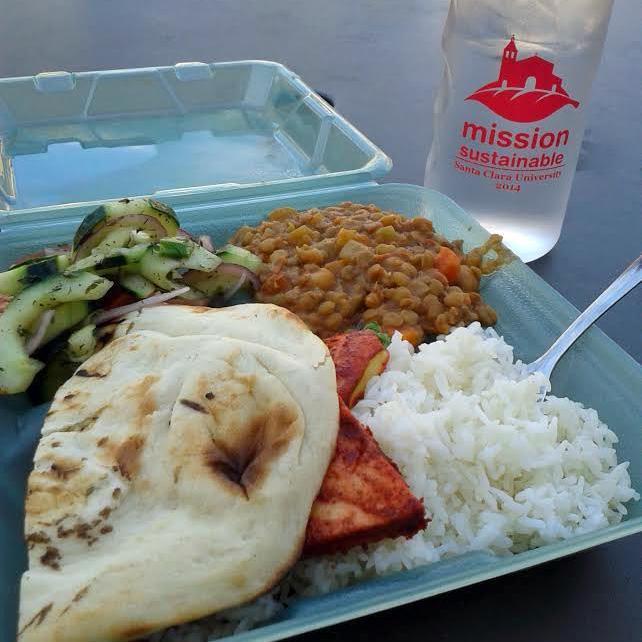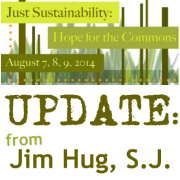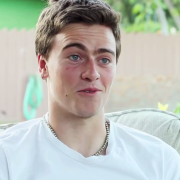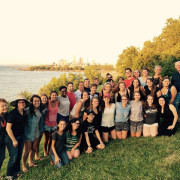Fighting for a Zero-Waste Campus at Santa Clara University
BY KAITLIN WHEELER | February 28, 2019
With bustling students, long lines and plates of food stacked high, waste management does not appear to be a high priority when walking through Santa Clara University’s Benson Memorial Center. But Santa Clara’s zero-waste plan is on a mission to change this by 2020, with the help of the Center for Sustainability (CFS) which is developing steps for accomplishing these goals.
Since last year, the Auxiliary Services division on campus has attempted to decrease the use of single-use service wear along with the amount of food being taken to the dump by administering reusable eco-trays to all on-campus residents. This was one of the first priorities in the zero-waste plan in order to provide reusable containers to students.

A reusable “eco-tray” at Santa Clara University.
Lindsey Kalkbrenner, director of the CFS, was one of the main contributors in drafting this future plan, along with other members from her team.
But what does zero-waste mean? Kalkbrenner explained that 90 percent of the waste from the university must be diverted from landfills. In other words, by 2020, recycling and compost need to make up 90 percent of the campus’ waste, with 10 percent left over for the landfill.
To achieve this goal, certain steps need to be taken by faculty and students of the university, according to Kalkbrenner. These steps include improving the signage on campus, providing students with reusable eco-trays and utensils as well as educating staff on the best methods for sorting waste—which can be accomplished by providing training to Benson workers on utilizing composting bins.
Santa Clara sophomore Michael Terry, a zero waste intern with the CFS, said that in order to accomplish these objectives, the necessary components need to be fairly easy and accessible for members of the university.
Terry noticed fellow classmates frustrated with certain changes in Benson including the use of eco-trays, the disappearance of Tapingo—a service that allows students to pre-order food—and the lack of single-use to-go service ware.
According to Terry, the demand for single-use cups and plates will decrease without Tapingo as students are required to bring an eco-tray as a to-go container.
“The average person is not motivated enough to make huge disruptive changes in their lives,” he said. “It’s a lot more work to them even if it’s eco-friendly.”
Terry is determined to create obtainable steps for students to smoothly transition into more sustainable habits.
To encourage students to become aware of their daily waste production, environmental studies and sciences professor Stephanie Hughes turned her classroom into a living laboratory for studying this issue on campus.
Since 2011, Hughes has taught a class on Garbology, where students are instructed to complete a waste characterization on campus buildings.
This process consists of opening up the landfill bags from a particular building, laying out the trash on tarps or tables and sorting the waste piece by piece into their correct categories, whether that be landfill, compost or recycling.

The Center for Sustainability hosted the Campus Sustainability Day Fair in October 2018. It recognized involved community members by showcasing programs and local businesses with a sustainable component. [Nick Kniveton — The Santa Clara]
During the most recent waste characterization of the first floor of the Learning Commons in the second week of fall quarter, Hughes and students discovered that 51 percent of items that should have been composted were put into the landfill. Additionally, 50 percent of the plastics that needed to be recycled were placed in the landfill.
This has been a large concern for Kalkbrenner and the CFS team as they strive to find ways to teach and encourage people to correctly sort their waste.
According to measurements on waste conducted by the CFS in 2010—the first year the university invested in composting—of the 1,600 tons of waste produced by the campus, four percent was composted.
As of 2017, of the 2,189 tons of waste recorded, 45 percent was composted. The numbers exhibit substantial improvements in achieving the zero-waste initiative.
“The idea of reducing source waste is really what we need to do to get to zero-waste,” Kalkbrenner said. “But also we need to stop wasting money and materials and reduce our impact on the planet.”
She believes people need to stop creating a demand for single-use items and instead switch to reusable products to cut down on the amount of resources being used and excessive waste that comes from this process.
Even with the substantial improvements in diverting waste, Kalkbrenner and the CFS employees wanted members of the university to stop utilizing single-use items such as plastic coffee cups and utensils all together and to be cautious of the food waste they produce as individuals.
According to Mission Sustainable, the website where the Strategic Sustainability Plan will be published, the per capita production of waste was 517.8 pounds over the academic year of 2017.
The majority of the campus’ waste is compacted and transported to Mission Trails, a company which then sorts the waste at a materials recovery facility five minutes from campus.
From there, compostable waste and landfill materials are sent to Newby Island, located on the shore of San Francisco Bay. According to Mission Trails, it costs $29.51 per cubic yard of landfill to be transported from campus.
Since China enforced the National Sword Policy on Jan. 1, 2018, the United States has been banned on shipping certain recyclables, meaning that there has been a higher demand for national recycling and waste facilities.
With this change, the campus was forced to switch the company they paid to collect its waste due to the original company they were using increasing costs.
The zero-waste plan also aspires toward 10 percent of food waste and five percent of waste per capita reduction by 2020.
With these factors, Kalkbrenner knows that announcing these sustainability goals may be a challenge for her team to accomplish, but through the center’s strategic steps in education and awareness surrounding the topic of becoming conscious consumers.
“We want to get students excited and they’re only here for four years,” Kalkbrenner said. “Having those lofty goals only pushes us to try harder.”
[Editor’s note: This piece was originally published by The Santa Clara]









Thus wrote Mahatma Gandhi: “Nature produces sufficient for everyone’s need but not enough for everyone’s greed.”
Love your article! So good to hear more campuses are striving for zero waste! I work for a company that is trying to reduce food waste by sharing it with the local communities. So it can connect businesses to get their unsold food at the end of the day to be eaten and not thrown away. But anyone can give or receive on the app, sounds like something Santa Clara could have a look into rolling it out on their campus!
Outstanding publications. I absolutely appreciate how much knowledge can be found here.